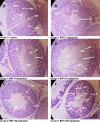Effect of bisphenol F, an analog of bisphenol A, on the reproductive functions of male rats
- PMID: 31182008
- PMCID: PMC6558835
- DOI: 10.1186/s12199-019-0797-5
Effect of bisphenol F, an analog of bisphenol A, on the reproductive functions of male rats
Abstract
Objective: Bisphenol A (BPA) is a monomer primarily used in the production of polycarbonate plastic and epoxy resins. Bisphenol F (BPF) is apparently the main BPA replacement that is used increasingly. BPF has been detected in canned food, thermal paper receipts, and soft drinks. In the present experiment, we did both in vitro and in vivo studies to evaluate the effect of low and high-dose BPF exposures on testosterone concentration, oxidative stress, and antioxidants activity in reproductive tissues of male rats.
Methods: Adult (80-90 days old) male Sprague Dawley rats (n = 36) obtained from the rodent colony of Animal Sciences Department of Quaid-i-Azam University. The direct effects of BPF on the antioxidant enzymes and testosterone secretion were measured in vitro and in vivo studies. In an in vivo experiment, adult male Sprague Dawley rats (n = 42) were exposed to different concentrations of bisphenol F (1, 5, 25, and 50 mg/kg/d) for 28 days. Various biochemical parameters were analyzed including the level of catalase (CAT), superoxide dismutase (SOD), peroxidase (POD), reactive oxygen species (ROS), and lipid peroxidation (LPO). Moreover, sperm motility, daily sperm production (DSP), comet assay, and histological analysis were performed.
Results: In vitro study showed that BPF exposure significantly (p < 0.05) induced oxidative stress biomarkers, i.e., ROS and LPO, while it did not change antioxidant enzyme and testicular testosterone concentration. Whereas, an in vivo study revealed that BPF induced dose-dependent effect and high-dose (100 mg/kg) exposure of BPF significantly reduced tissue protein (p < 0.05) content, CAT (p < 0.001), SOD (p < 0.05), and POD (p < 0.05) levels while significantly (p < 0.05) augmented ROS and lipid peroxidation. Furthermore, BPF reduces testosterone, LH, and FSH secretion in a dose-dependent manner. Significant (p < 0.001) reduction in plasma and intra-testicular testosterone, LH, and FSH was noticed at 100 mg/kg BFP dose. High-dose exposure reduces spermatogenesis.
Conclusion: BPF showed an antagonistic effect on male reproductive hormones and induce alterations in testicular morphology. Increased oxidative stress and decreased testicular antioxidant status might be the underlying mechanism of BFP-induced testicular toxicity.
Keywords: Antioxidant enzymes; Bisphenol F; Male reproductive system; Oxidative stress; Reproductive toxicity.
Conflict of interest statement
The authors declare that they have no competing interests.
Figures



Similar articles
-
Impact of low-dose chronic exposure to bisphenol A and its analogue bisphenol B, bisphenol F and bisphenol S on hypothalamo-pituitary-testicular activities in adult rats: A focus on the possible hormonal mode of action.Food Chem Toxicol. 2018 Nov;121:24-36. doi: 10.1016/j.fct.2018.08.024. Epub 2018 Aug 16. Food Chem Toxicol. 2018. PMID: 30120946
-
Bisphenol A and its analogs bisphenol B, bisphenol F, and bisphenol S: Comparative in vitro and in vivo studies on the sperms and testicular tissues of rats.Chemosphere. 2018 Oct;209:508-516. doi: 10.1016/j.chemosphere.2018.06.089. Epub 2018 Jun 19. Chemosphere. 2018. PMID: 29940534
-
Bisphenol A analogues bisphenol B, bisphenol F, and bisphenol S induce oxidative stress, disrupt daily sperm production, and damage DNA in rat spermatozoa: a comparative in vitro and in vivo study.Toxicol Ind Health. 2019 Apr;35(4):294-303. doi: 10.1177/0748233719831528. Epub 2019 Mar 14. Toxicol Ind Health. 2019. PMID: 30871434
-
A new chapter in the bisphenol A story: bisphenol S and bisphenol F are not safe alternatives to this compound.Fertil Steril. 2015 Jan;103(1):11-21. doi: 10.1016/j.fertnstert.2014.11.005. Epub 2014 Dec 2. Fertil Steril. 2015. PMID: 25475787 Review.
-
Adverse effects of bisphenol A on male reproductive function.Rev Environ Contam Toxicol. 2014;228:57-82. doi: 10.1007/978-3-319-01619-1_3. Rev Environ Contam Toxicol. 2014. PMID: 24162092 Review.
Cited by
-
Urinary Bisphenol A, F and S Levels and Semen Quality in Young Adult Danish Men.Int J Environ Res Public Health. 2021 Feb 11;18(4):1742. doi: 10.3390/ijerph18041742. Int J Environ Res Public Health. 2021. PMID: 33670148 Free PMC article.
-
High-content imaging analyses of the effects of bisphenols and organophosphate esters on TM4 mouse Sertoli cells†.Biol Reprod. 2022 Sep 12;107(3):858-868. doi: 10.1093/biolre/ioac101. Biol Reprod. 2022. PMID: 35596243 Free PMC article.
-
Oxidative stress increases in liver of lactating rats after BPF-low-dose exposure: perinatal effects in the offspring.Sci Rep. 2023 Jul 11;13(1):11229. doi: 10.1038/s41598-023-38434-w. Sci Rep. 2023. PMID: 37433837 Free PMC article.
-
Elucidation of the Effects of Bisphenol A and Structural Analogs on Germ and Steroidogenic Cells Using Single Cell High-Content Imaging.Toxicol Sci. 2021 Apr 12;180(2):224-238. doi: 10.1093/toxsci/kfab012. Toxicol Sci. 2021. PMID: 33501994 Free PMC article.
-
Can Bisphenols Alter the Inflammation Process?Life (Basel). 2025 May 14;15(5):782. doi: 10.3390/life15050782. Life (Basel). 2025. PMID: 40430209 Free PMC article. Review.
References
-
- Commission E Commission Regulation (EU) No 10/2011 of 14 January 2011 on plastic materials and articles intended to come into contact with food. Off J Eur Union. 2011;12:1–89.
MeSH terms
Substances
LinkOut - more resources
Full Text Sources
Medical
Miscellaneous
